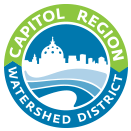Capitol Region Watershed District’s Targeted Watershed Program (TWP) features projects and programs designed to help improve water quality in Como Lake, which is impaired for phosphorus, and protect Lake McCarrons which has demonstrated a decline in water quality in recent years but is not designated as impaired.
To meet state standards, Como will require a 60 percent reduction in phosphorus from stormwater runoff and a 97 percent reduction in phosphorus being recycled inside of the lake. Excess phosphorus fuels algae growth, and less phosphorus means clearer, healthier water.
An estimated 4.48 million people visit Como Lake Regional Park each year. The lake is a highly valued, iconic natural resource in the Twin Cities metropolitan area. Lake McCarrons spans nearly 75 acres and hosts swimming, boating, and fishing. A Ramsey County Park provides public access and features the only designated public swimming beach in CRWD. The benefits of this project are expected to improve water quality and recreation opportunities for millions of Minnesota residents.
Capitol Region Watershed District (CRWD) received a $1.76 million grant award from the Minnesota Board of Water and Soil Resources (BWSR) to improve water quality in Como Lake and Lake McCarrons. The funds, made available through the Clean Water, Land and Legacy Amendment, were approved by BWSR as part of their Targeted Watershed Program.
CRWD’s Targeted Watershed Program will expand on existing partnerships to install best management practices (BMPs) and increase public awareness of activities that protect water resources. Some of these efforts include:
- Analyzing key areas for cost-effective BMP implementation
- Constructing new large-scale BMPs
- Coordinating design and construction of residential boulevard rain gardens
- Growing CRWD’s residential “Adopt-a-Drain” program
- Expanding neighborhood leaf clean-up events
Project Results
In 2017, CRWD completed the first Targeted Watershed Program large-scale BMP. Partnering with the City of Saint Paul and the Saint Paul School District, an underground infiltration pipe gallery was installed below the new athletic field at Como Park Senior High School. Stormwater is diverted from the public storm sewer into the pipe gallery where it has time to soak into the ground. The $600,000 project will prevent 17 pounds of phosphorus from reaching Como Lake each year.
CRWD also completed a feasibility study to identify cost-effective stormwater treatment opportunities within Como Regional Park. The goal was to shift from trying to install small BMPs when park improvements occur to installing fewer, larger BMPs that will eventually treat the entire park and portions of surrounding neighborhoods. Several BMPs identified in the study have been selected for additional design with the goal of installing by 2020.
Residential boulevard rain gardens are another key component of the Targeted Watershed Program. In the McCarrons subwatershed, 64 properties were identified as ideal sites for curb-cut rain gardens. As a result of community outreach, 16 rain gardens will be constructed by fall 2018. A similar effort is taking shape for neighborhoods in the Como Lake subwatershed. Site identification began with a volunteer event coordinated with the District 10 Community Council. Site evaluation will continue this summer and public promotion is expected to begin in fall 2018.
CRWD worked closely with the Como Active Citizen Network to develop a model for curb clean-ups in the neighborhood surrounding Como Lake. Next steps are to present the model to residents of Como Lake and Lake McCarrons as part of a workshop planned for winter 2019.
The program also successfully expanded the Adopt-a-Drain promotion, with emphasis placed on the Lake McCarrons neighborhood, in the fall of 2017. There are currently 44 homes in the Lake McCarrons subwatershed participating in the program, and an additional 100 Adopt-a-Drain program participants in the Como Lake watershed.
Act now to get involved with CRWD’s residential watershed protection program.
